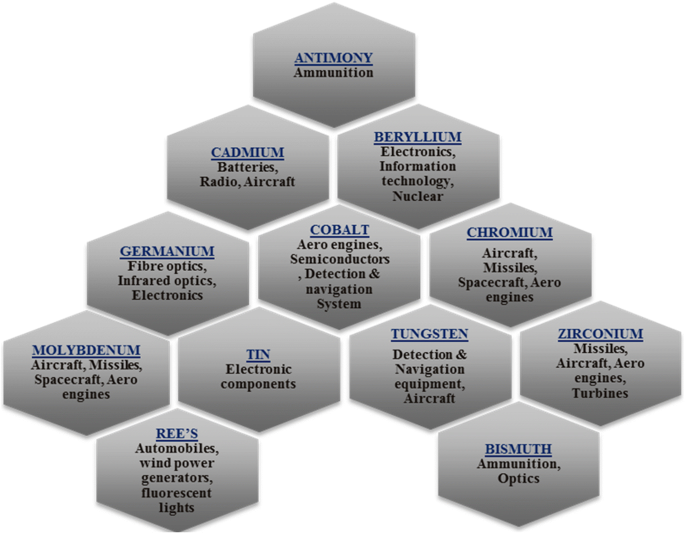
Disclaimer: Copyright infringement not intended.
Context
- Twenty important mineral blocks are currently up for auction for commercial mining by the private sector.
- The bidding procedure began on November 29 and will continue until January 22 of the following year.
What are Critical Minerals?
- A mineral is critical when the danger of supply shortfall and the resulting economic impact is (relatively) higher than for other raw resources.
- These minerals are critical for economic development and national security, and their scarcity/concentration of extraction/processing in a few geographical areas may result in supply chain vulnerabilities.
- These elements (including lithium, graphite, cobalt, titanium, and rare earth elements) are critical for the progress of numerous industries, including high-tech electronics, telecommunications, transportation, and defence.
It is a component of several important value chains, including
- Clean technology projects such as zero-emission automobiles, wind turbines, and solar panels; information and communication technologies such as semiconductors; and
- Defense applications, permanent magnets, and ceramics are examples of advanced manufacturing inputs and materials.
Recent Efforts by the Indian Govt to Boost its Critical Minerals Sector
- The Indian government has identified 30 critical minerals.
- These minerals are Antimony, Beryllium, Bismuth, Cobalt, Copper, Gallium, Germanium, Graphite, Hafnium, Indium, Lithium, Molybdenum, Niobium, Nickel, PGE, Phosphorous, Potash, REE, Rhenium, Silicon, Strontium, Tantalum, Tellurium, Tin, Titanium, Tungsten, Vanadium, Zirconium, Selenium and Cadmium.
Permitted mining
- Earlier this year, the government revised a fundamental statute to allow for the mining of three essential minerals: lithium, niobium, and rare earth elements (REEs).
- To entice bidders, the government set new royalty rates for important minerals that corresponded to worldwide norms.

The Geological Survey of India has increased its exploration efforts
- In the current fiscal year, the Geological Survey of India has undertaken 125 projects to investigate significant mineral reserves in the country.
- It conducted mineral exploration in the Salal-Haimna areas (Reasi district, J&K), estimating 5.9 million tonnes of lithium ore.
- A total of 625 mineral exploration projects were undertaken throughout the previous eight fiscal years.
Centre of Excellence for Critical Minerals
- Report of the Committee on Identification of Critical Minerals, released in June 2023, recommended that a Centre of Excellence for Critical Minerals should be established.
- This is to frame policies and incentives for creating a complete value chain of critical minerals in the country.
Khanij Bidesh India Ltd. (KABIL)
- A joint venture company namely Khanij Bidesh India Ltd. (KABIL) is mandated to identify and acquire overseas mineral assets of critical and strategic nature (lithium, cobalt) to ensure supply side assurance.
The Mineral Security Partnership (MSP)
- India has recently joined the Mineral Security Partnership (MSP).
- It is a US-led collaboration of 14 countries that intends to stimulate public and private investment in vital mineral supply chains around the world.
News Summary: Mining for critical minerals
- The Ministry of Mines has floated the Notice Inviting Tender (NIT) for 20 blocks are spread over eight states.
- The mineral blocks contain lithium ore and another 10 of the 30 minerals that the government declared as “critical” in July.
- This is the first time that rights related to the mining of lithium ore are being auctioned to private parties.
What are the estimated reserves of key critical minerals in these blocks?
J&K Block
- The J&K block has an inferred reserve of a 5.9 million tonne (mt) of bauxite column, which contains more than 3,400 tonnes of lithium metal content.
- This block also contains more than 70,000 tonnes of titanium metal content.
Chhattisgarh block
- The block in Chhattisgarh contains lithium and REEs, but no drilling has been conducted yet to estimate total reserves.
Other blocks
- Nickel ore reserves have been found in three blocks, one each in Bihar, Gujarat, and Odisha.
- No drilling has been conducted for the blocks in Bihar and Gujarat.
- In the Odisha block, the NIT states an inferred value of 2.05 mt of nickel ore, which amounts to 3,908 tonnes of nickel metal content.

How does India currently get its supplies of these minerals?
- In FY23, India imported 2,145 tonnes of lithium carbonate and lithium oxide.
- Lithium carbonate contains up to 19 percent lithium. Lithium oxide, which is usually converted to lithium hydroxide, contains 29 percent lithium.
- India also imported 32,000 tonnes of unwrought nickel and 1.2 million tonnes of copper ore in 2022-23.
- India is 100 percent reliant on imports for its lithium and nickel demand. For copper, this figure is 93 percent.
|
PRACTICE QUESTION
Critical minerals play a pivotal role in the development of modern technologies, ranging from renewable energy to advanced electronics. Discuss the significance of critical minerals in the context of India's socio-economic development.
|




